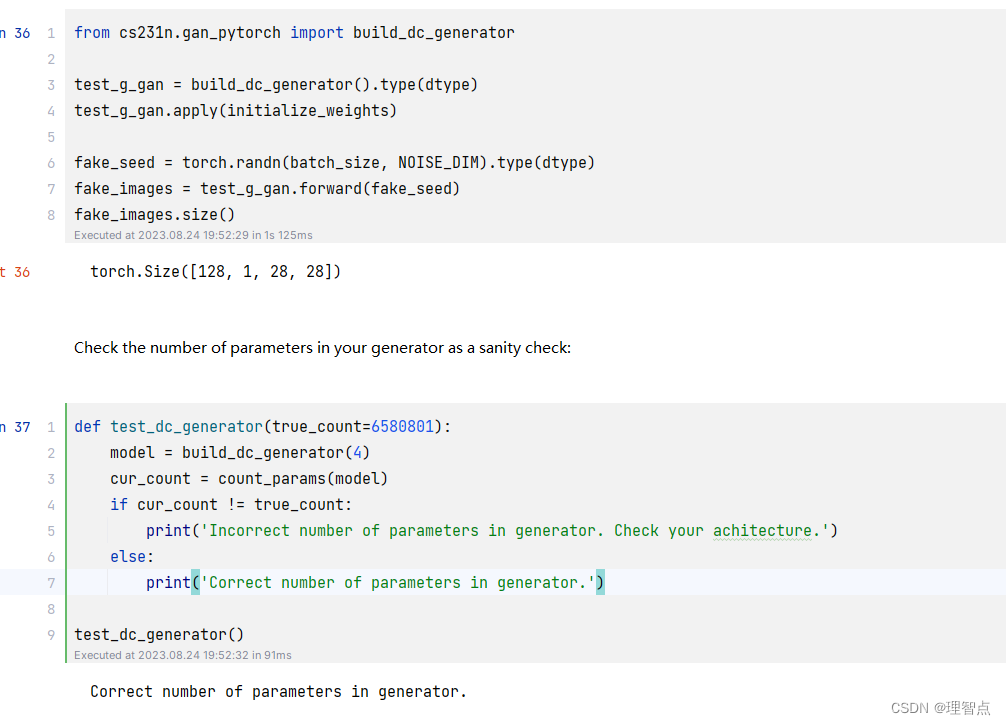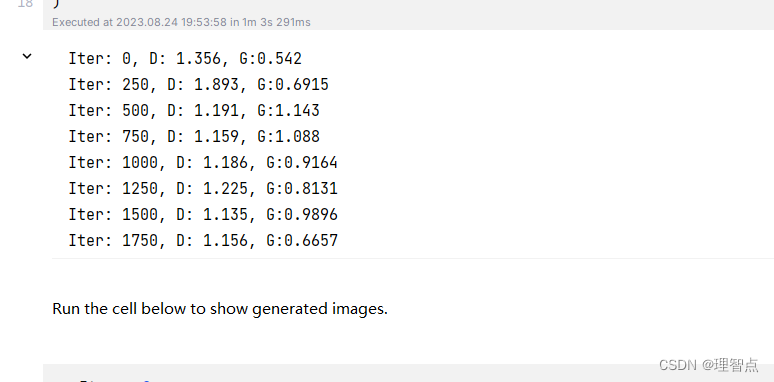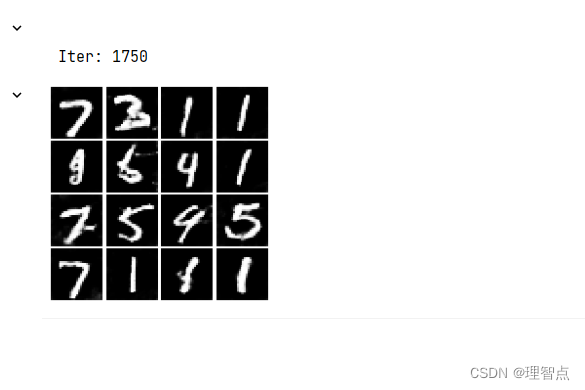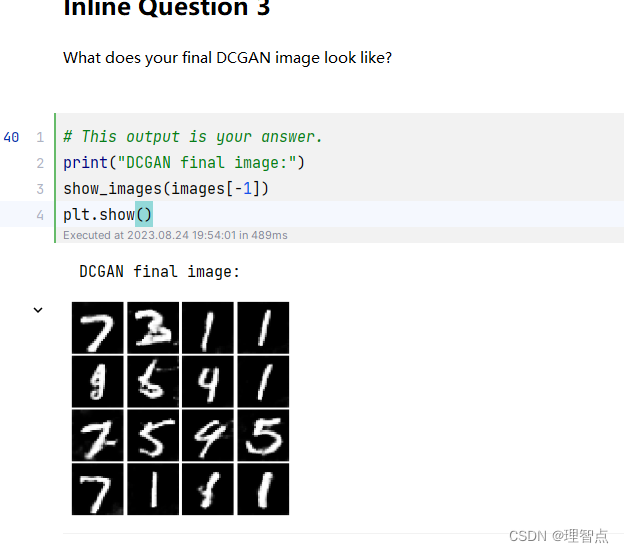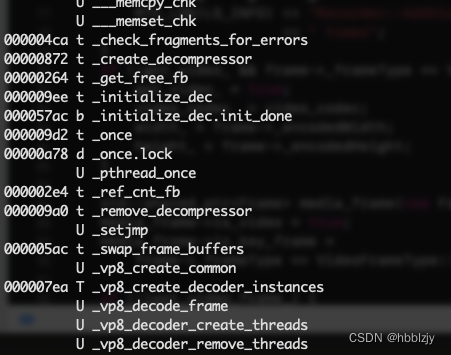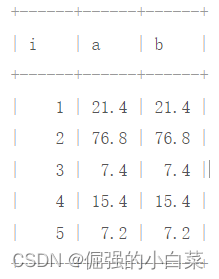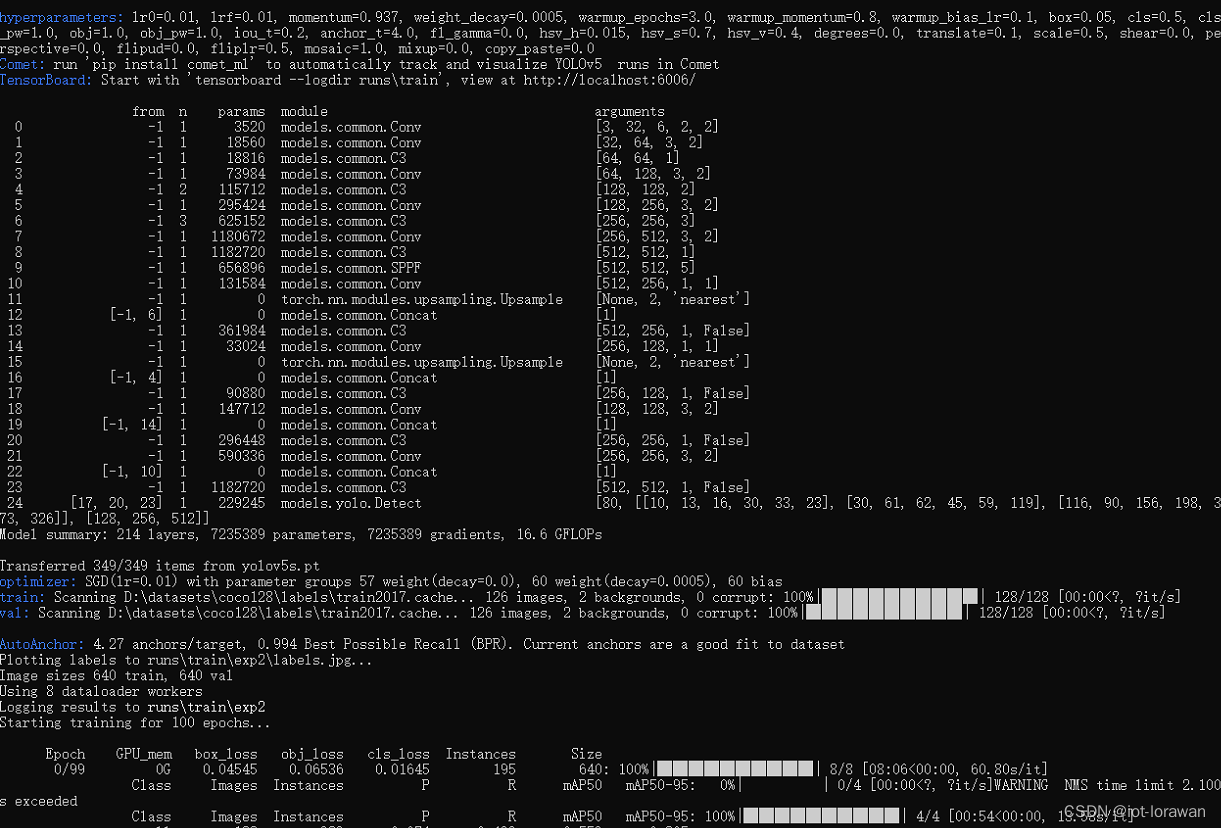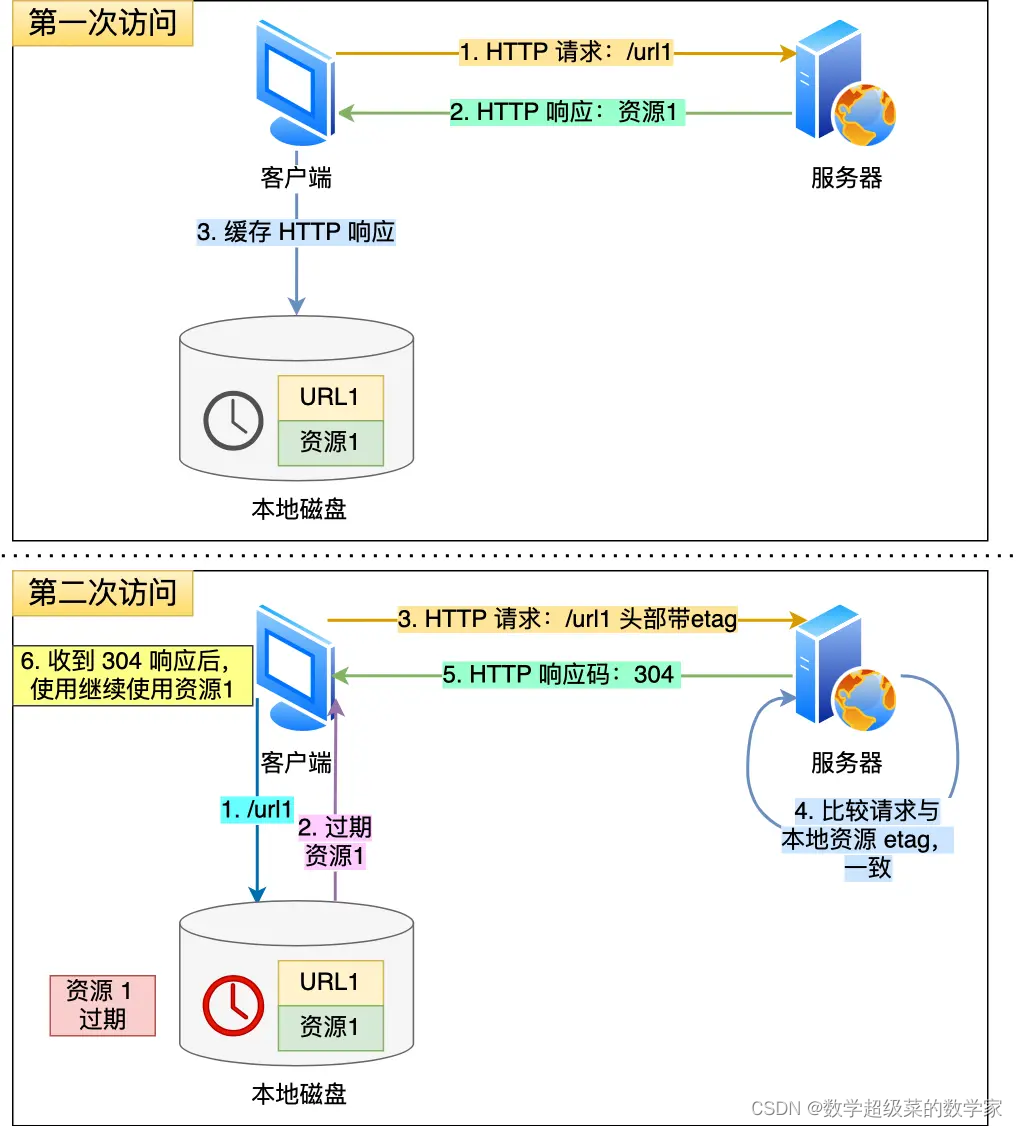文章目录
- 嫌墨迹直接看代码
- Q4 :Generative Adversarial Networks
- sample_noise
- 题面
- 解析
- 代码
- 输出
- discriminator
- 题面
- 解析
- 代码
- 输出
- generator
- 题面
- 解析
- 代码
- 输出
- discriminator_loss
- 题面
- 解析
- 代码
- 输出
- generator_loss
- 题面
- 解析
- 代码
- get_optimizer
- 题面
- 解析
- 代码
- 输出
- ls_discriminator_loss ls_generator_loss
- 题面
- 解析
- 代码
- 输出
- build_dc_classifier
- 题面
- 解析
- 代码
- 输出
- build_dc_generator
- 题面
- 解析
- 代码
- 输出
嫌墨迹直接看代码
Q4 :Generative Adversarial Networks
sample_noise
题面
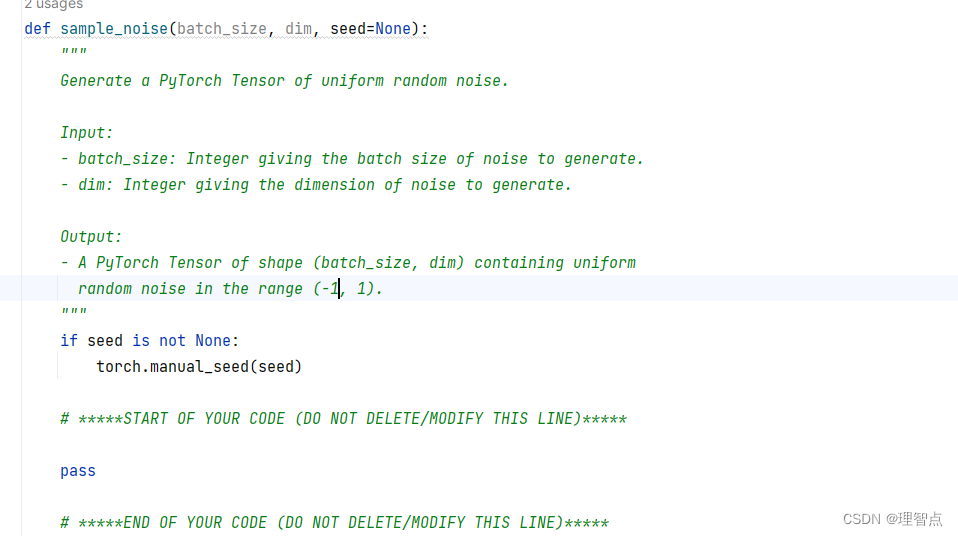
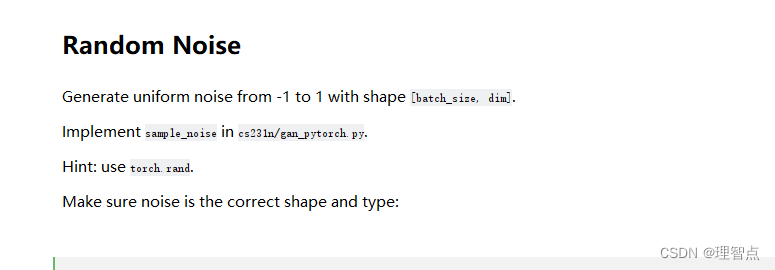
就是让我们生成噪音,使用torch.rand就好了注意我们的噪音区间应该在 (-1,1)
而torch.rand生成的在(0,1)
解析
看代码就好了
代码
def sample_noise(batch_size, dim, seed=None):"""Generate a PyTorch Tensor of uniform random noise.Input:- batch_size: Integer giving the batch size of noise to generate.- dim: Integer giving the dimension of noise to generate.Output:- A PyTorch Tensor of shape (batch_size, dim) containing uniformrandom noise in the range (-1, 1)."""if seed is not None:torch.manual_seed(seed)# *****START OF YOUR CODE (DO NOT DELETE/MODIFY THIS LINE)*****return torch.rand(batch_size, dim) * 2 - 1# *****END OF YOUR CODE (DO NOT DELETE/MODIFY THIS LINE)****
输出
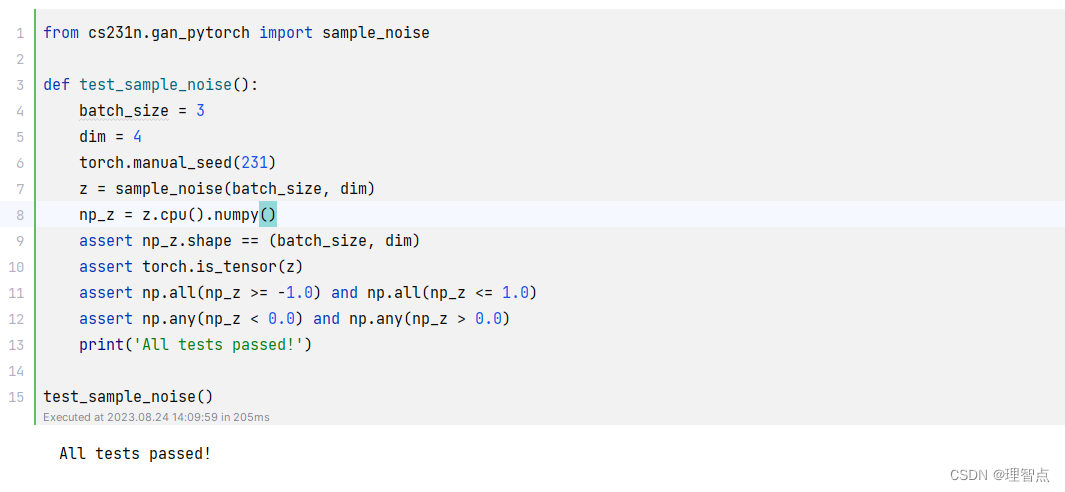
discriminator
题面


让我们使用nn.Sequential来搭建一个识别网络
解析
没啥好说的,pytorch的使用在之前我们也学习过了,直接调用相关api就好了,如果又不懂得看代码就好了
代码
def discriminator(seed=None):"""Build and return a PyTorch model implementing the architecture above."""if seed is not None:torch.manual_seed(seed)model = None############################################################################### TODO: Implement architecture ## ## HINT: nn.Sequential might be helpful. You'll start by calling Flatten(). ################################################################################ *****START OF YOUR CODE (DO NOT DELETE/MODIFY THIS LINE)*****model = nn.Sequential(nn.Flatten(),nn.Linear(784, 256),nn.LeakyReLU(0.01),nn.Linear(256, 256),nn.LeakyReLU(0.01),nn.Linear(256, 1))# *****END OF YOUR CODE (DO NOT DELETE/MODIFY THIS LINE)*****############################################################################### END OF YOUR CODE ###############################################################################return model
输出
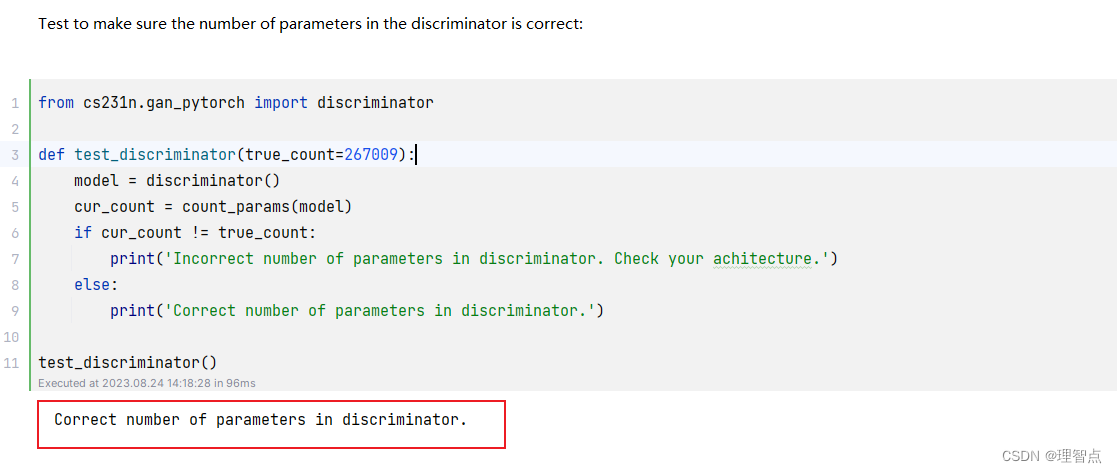
generator
题面
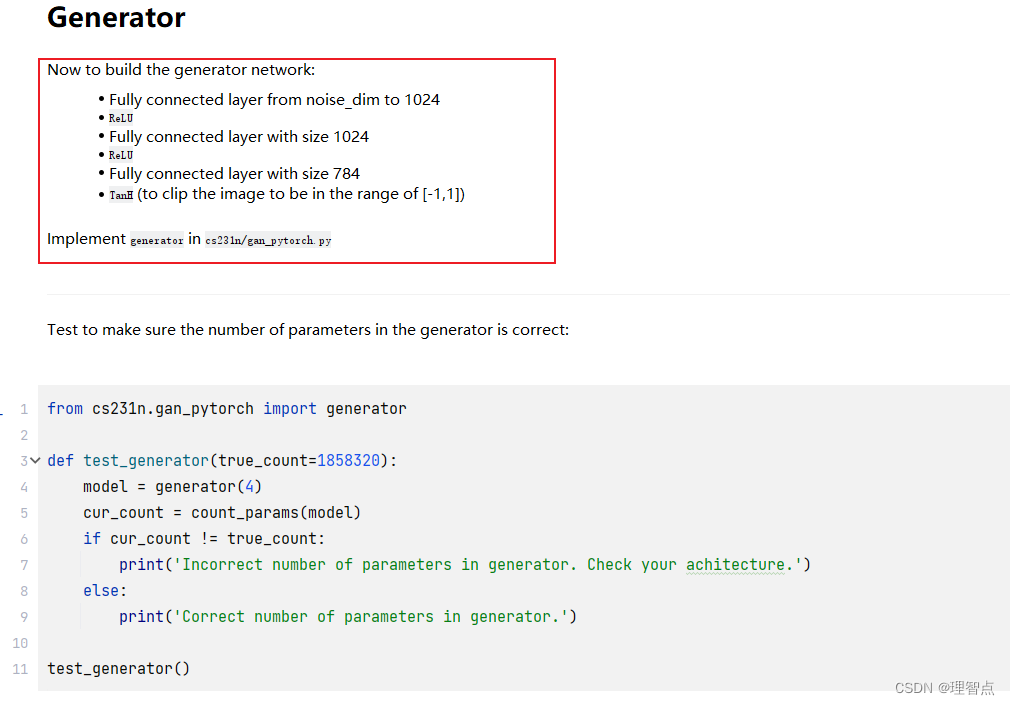

就是让我们按照上面的网络结构搭建一个简单的生成器网络
解析
看代码就好了
代码
def generator(noise_dim=NOISE_DIM, seed=None):"""Build and return a PyTorch model implementing the architecture above."""if seed is not None:torch.manual_seed(seed)model = None############################################################################### TODO: Implement architecture ## ## HINT: nn.Sequential might be helpful. ################################################################################ *****START OF YOUR CODE (DO NOT DELETE/MODIFY THIS LINE)*****model = nn.Sequential(nn.Linear(noise_dim, 1024),nn.ReLU(),nn.Linear(1024, 1024),nn.ReLU(),nn.Linear(1024, 784),nn.Tanh())# *****END OF YOUR CODE (DO NOT DELETE/MODIFY THIS LINE)*****############################################################################### END OF YOUR CODE ###############################################################################return model
输出

discriminator_loss
题面
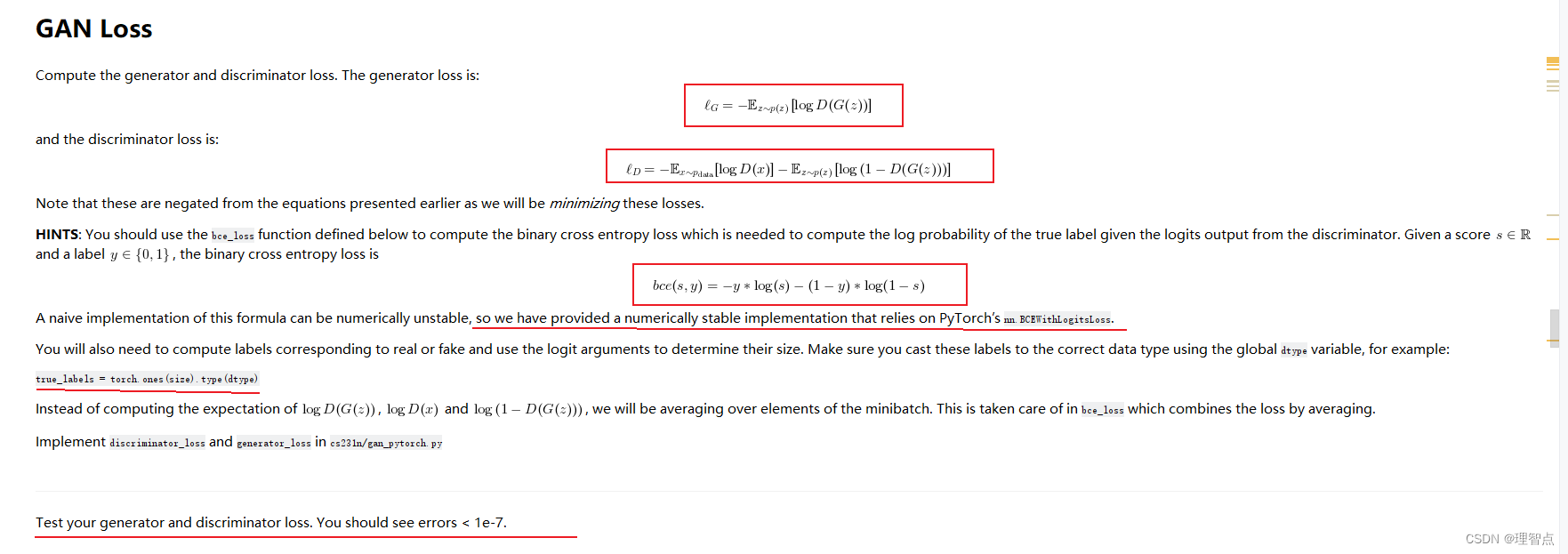
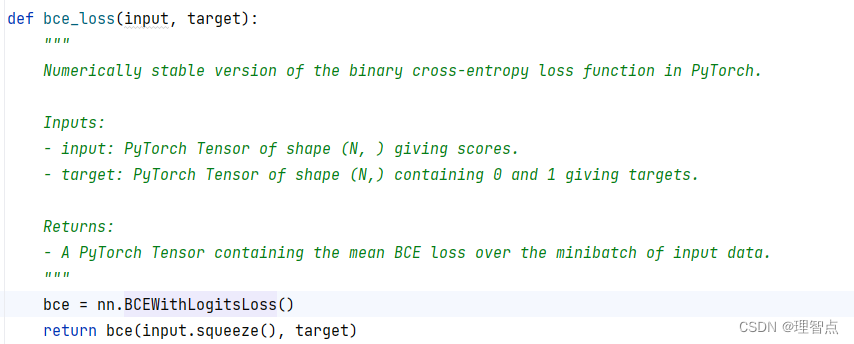
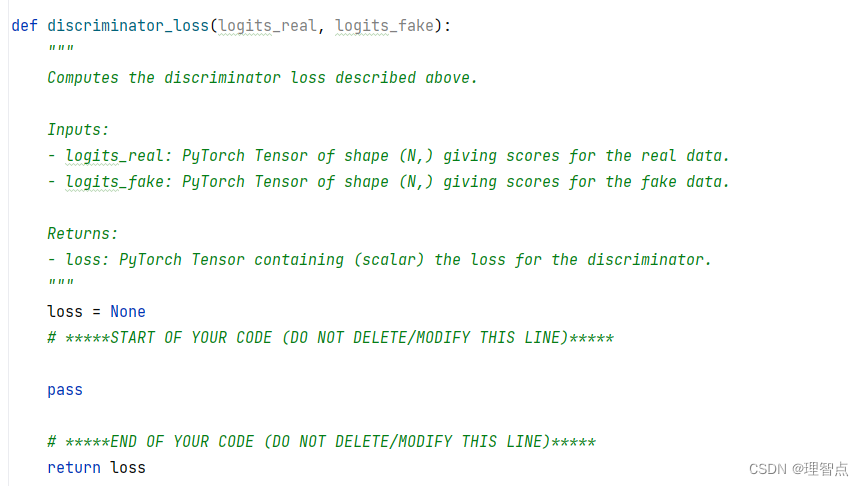
让我们计算判别器的损失,具体怎么计算在上面的公式里写了,其中需要使用的bce_loss函数已经让我们使用了pytorch的函数
关于bce_loss 交叉熵损失函数的讲解
解析
结合上面的材料,同时我的代码注释吧
代码
def bce_loss(input, target):"""Numerically stable version of the binary cross-entropy loss function in PyTorch.Inputs:- input: PyTorch Tensor of shape (N, ) giving scores.- target: PyTorch Tensor of shape (N,) containing 0 and 1 giving targets.Returns:- A PyTorch Tensor containing the mean BCE loss over the minibatch of input data."""bce = nn.BCEWithLogitsLoss()# 注意,原来给的代码是下面的代码,使用了Input.squeezed().后来我发现这样的话会导致input的size变成(N,)而target的size变成(N,1)# 导致报错,所以我把squeeze()去掉了,这样就不会出现这个问题了,或者你也可以两个都加上squeeze()# return bce(input.squeeze(), target)# 下面是我修改后的代码return bce(input, target)def discriminator_loss(logits_real, logits_fake):"""Computes the discriminator loss described above.Inputs:- logits_real: PyTorch Tensor of shape (N,) giving scores for the real data.- logits_fake: PyTorch Tensor of shape (N,) giving scores for the fake data.Returns:- loss: PyTorch Tensor containing (scalar) the loss for the discriminator."""loss = None# *****START OF YOUR CODE (DO NOT DELETE/MODIFY THIS LINE)*****# 获取正确分类的标签true_labels = torch.ones_like(logits_real).type(dtype)# 获取错误分类的标签false_labels = torch.zeros_like(logits_fake).type(dtype)# 为什么公式里是两个减法,而这里是两个加法呢?# 因为bce_loss已经帮我们取负值了,所以加法就可以了loss = bce_loss(logits_real, true_labels) + bce_loss(logits_fake, false_labels)# *****END OF YOUR CODE (DO NOT DELETE/MODIFY THIS LINE)*****return loss
输出

generator_loss
题面
同上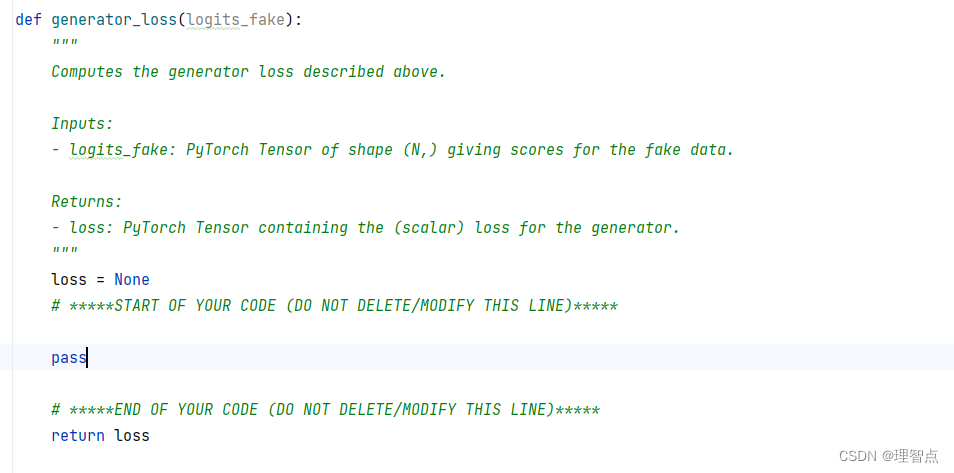
解析
看代码吧
代码
def generator_loss(logits_fake):"""Computes the generator loss described above.Inputs:- logits_fake: PyTorch Tensor of shape (N,) giving scores for the fake data.Returns:- loss: PyTorch Tensor containing the (scalar) loss for the generator."""loss = None# *****START OF YOUR CODE (DO NOT DELETE/MODIFY THIS LINE)*****# 为什么上面判别器loss的代码里fake的标签是0,而这里是1呢?# 因为这里是希望生成器生成的图片能够被判别器判别为真,所以标签是1false_label = torch.ones_like(logits_fake).type(dtype)loss = bce_loss(logits_fake, false_label)# *****END OF YOUR CODE (DO NOT DELETE/MODIFY THIS LINE)*****return loss
get_optimizer
题面

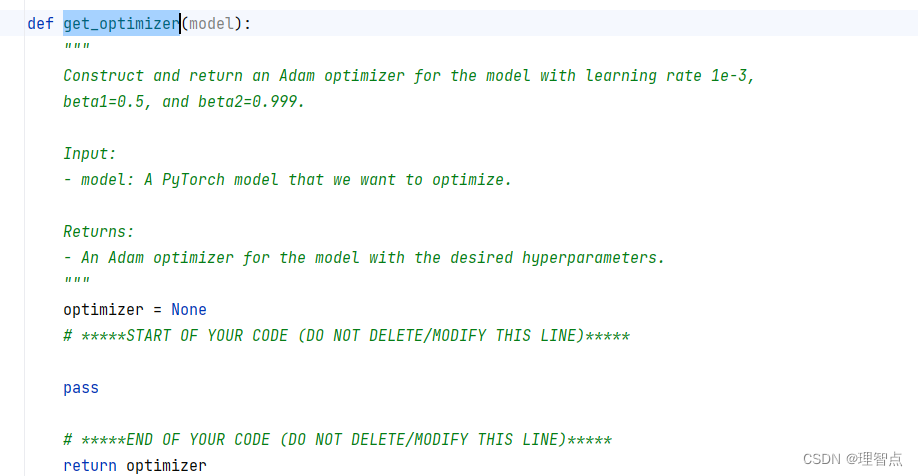
解析
看代码吧,这个就是个调用api
代码
def get_optimizer(model):"""Construct and return an Adam optimizer for the model with learning rate 1e-3,beta1=0.5, and beta2=0.999.Input:- model: A PyTorch model that we want to optimize.Returns:- An Adam optimizer for the model with the desired hyperparameters."""optimizer = None# *****START OF YOUR CODE (DO NOT DELETE/MODIFY THIS LINE)*****optimizer = torch.optim.Adam(model.parameters(), lr=1e-3, betas=(0.5, 0.999))# *****END OF YOUR CODE (DO NOT DELETE/MODIFY THIS LINE)*****return optimizer
输出
之后就是模型的训练了,直接看模型的训练结果好了
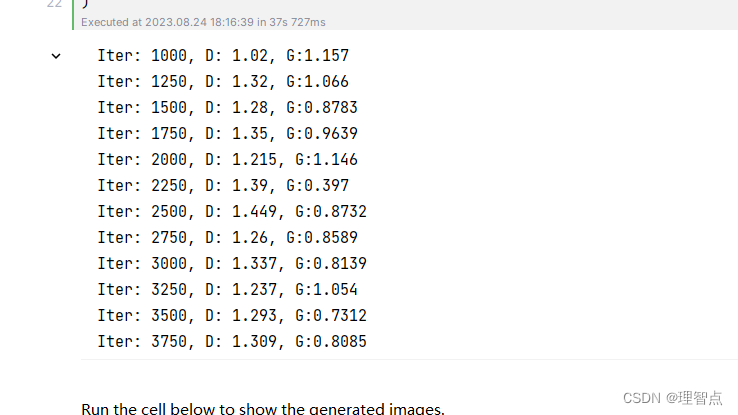
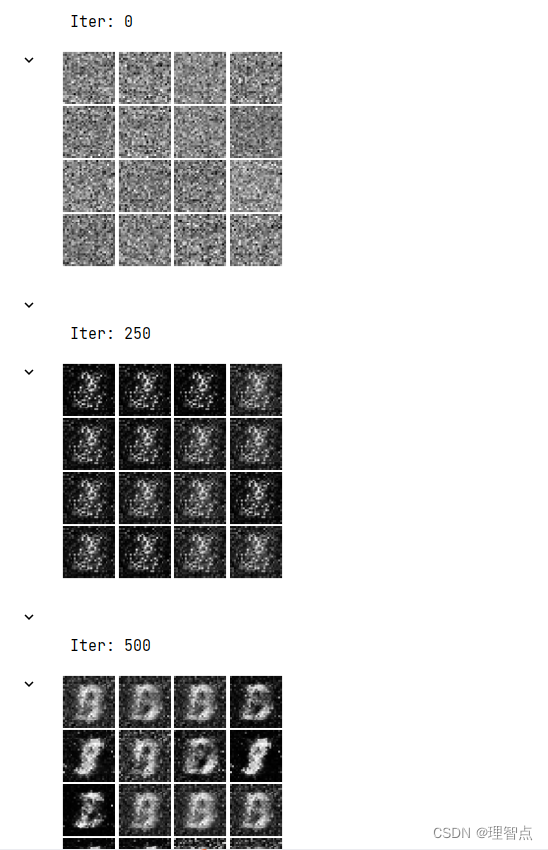
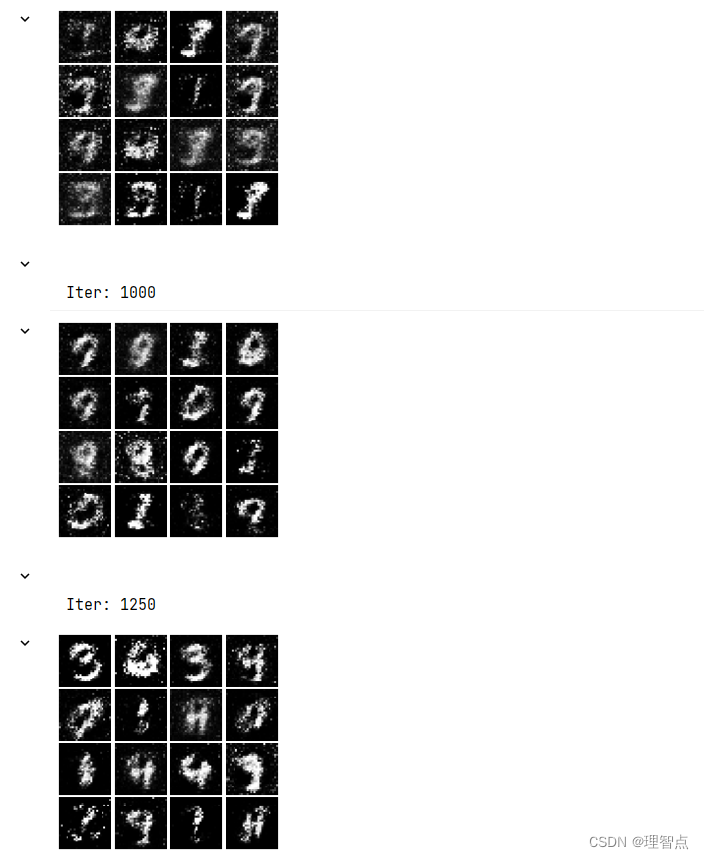
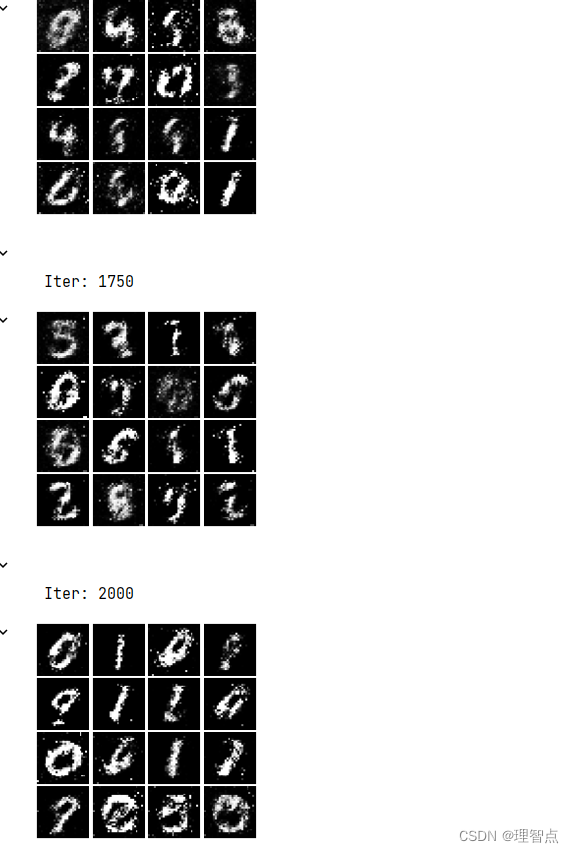
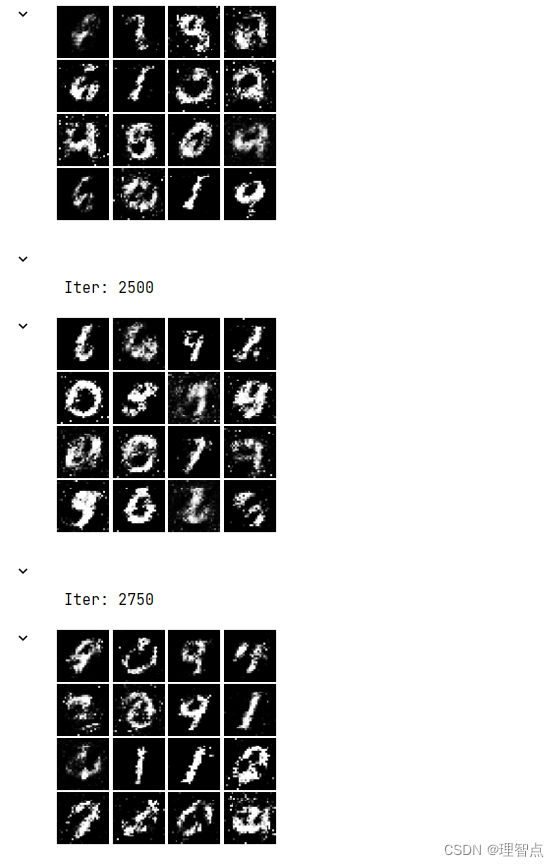
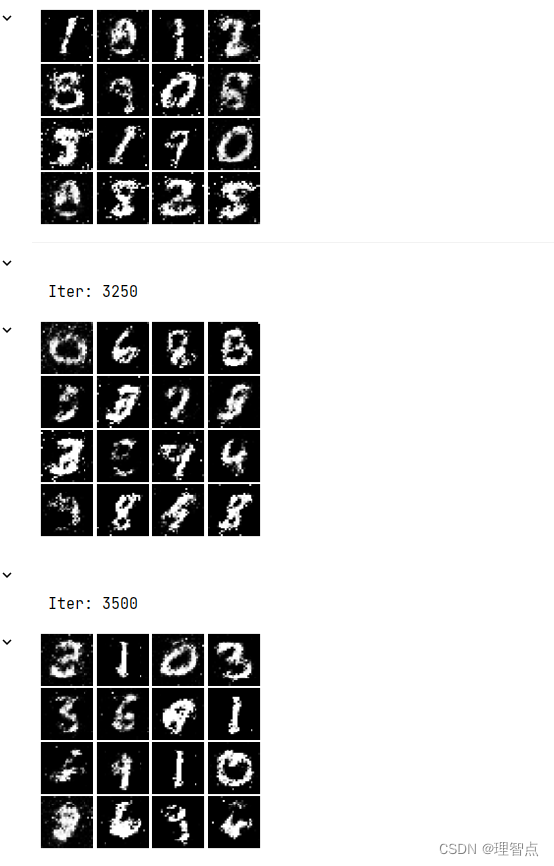
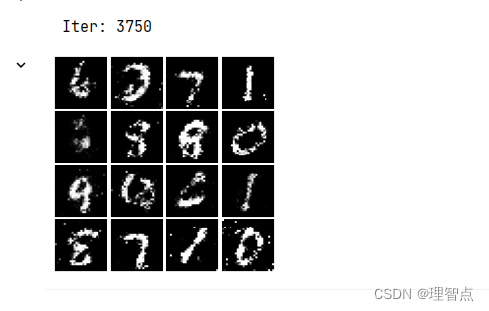
ls_discriminator_loss ls_generator_loss
题面

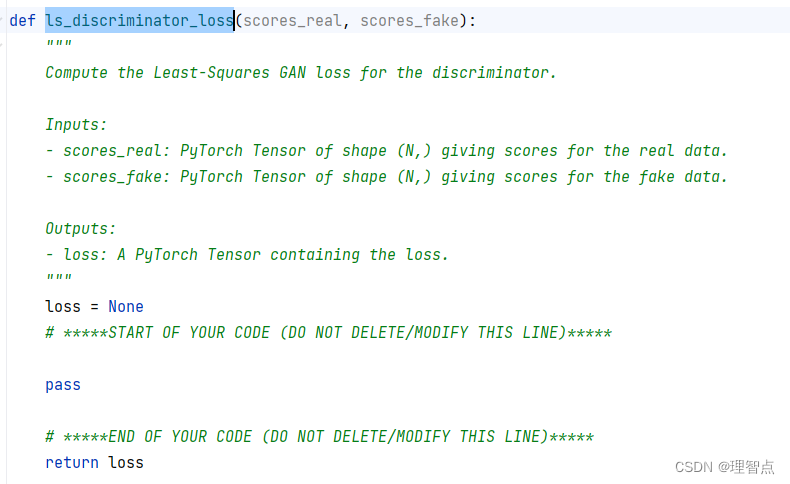
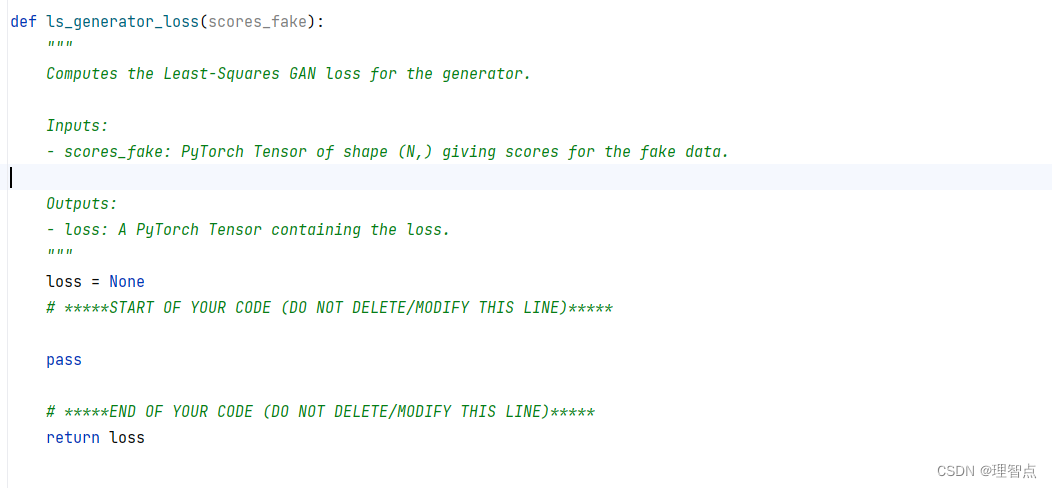
注意我们现在不需要使用二元交叉熵的函数,因为上面这个公式里的loss计算公式
对于生成器而言,就是生成的图片经识别后被认为是真实的可能性与1的距离越小越好,
因此我们只需要(计算他们两之间的距离)而对于鉴别器而言,就是原始数据集的图片经识别后被认为是真实的可能性与1的距离越小越好,
生成的图片经识别后被认为是真实的可能性与0的距离越小越好,
所以有了上面的loss计算公式
解析
看上面和代码
代码
def ls_discriminator_loss(scores_real, scores_fake):"""Compute the Least-Squares GAN loss for the discriminator.Inputs:- scores_real: PyTorch Tensor of shape (N,) giving scores for the real data.- scores_fake: PyTorch Tensor of shape (N,) giving scores for the fake data.Outputs:- loss: A PyTorch Tensor containing the loss."""loss = None# *****START OF YOUR CODE (DO NOT DELETE/MODIFY THIS LINE)*****loss = 0.5 * torch.mean((scores_real - 1) ** 2) + 0.5 * torch.mean(scores_fake ** 2)# *****END OF YOUR CODE (DO NOT DELETE/MODIFY THIS LINE)*****return lossdef ls_generator_loss(scores_fake):"""Computes the Least-Squares GAN loss for the generator.Inputs:- scores_fake: PyTorch Tensor of shape (N,) giving scores for the fake data.Outputs:- loss: A PyTorch Tensor containing the loss."""loss = None# *****START OF YOUR CODE (DO NOT DELETE/MODIFY THIS LINE)*****loss = 0.5 * torch.mean((scores_fake - 1) ** 2)# *****END OF YOUR CODE (DO NOT DELETE/MODIFY THIS LINE)*****return loss
输出

build_dc_classifier
题面


解析
照着做就好了
代码
def build_dc_classifier(batch_size):"""Build and return a PyTorch model for the DCGAN discriminator implementingthe architecture above."""############################################################################### TODO: Implement architecture ## ## HINT: nn.Sequential might be helpful. ################################################################################ *****START OF YOUR CODE (DO NOT DELETE/MODIFY THIS LINE)*****return nn.Sequential(Unflatten(batch_size, 1, 28, 28),nn.Conv2d(1, 32, kernel_size=5, stride=1),nn.LeakyReLU(0.01),nn.MaxPool2d(kernel_size=2, stride=2),nn.Conv2d(32, 64, kernel_size=5, stride=1),nn.LeakyReLU(0.01),nn.MaxPool2d(kernel_size=2, stride=2),Flatten(),nn.Linear(1024, 4 * 4 * 64),nn.LeakyReLU(0.01),nn.Linear(4 * 4 * 64, 1))# *****END OF YOUR CODE (DO NOT DELETE/MODIFY THIS LINE)*****############################################################################### END OF YOUR CODE ###############################################################################
输出
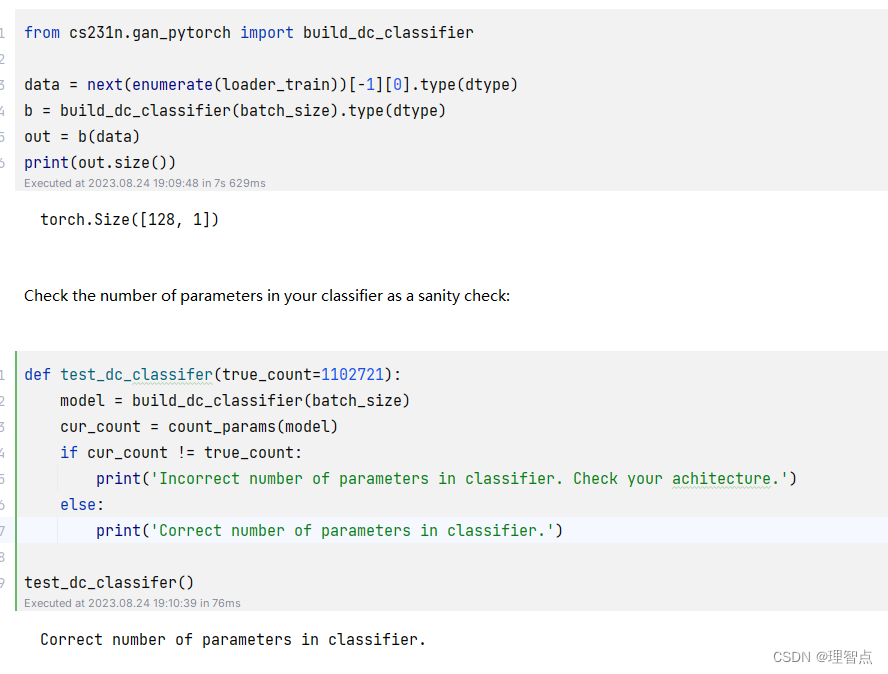
build_dc_generator
题面

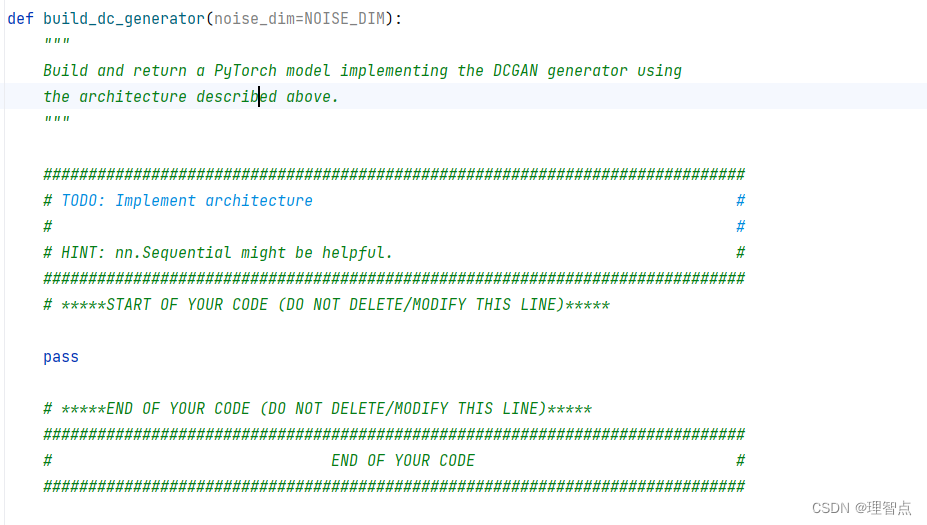
解析
同上
代码
def build_dc_generator(noise_dim=NOISE_DIM):"""Build and return a PyTorch model implementing the DCGAN generator usingthe architecture described above."""############################################################################### TODO: Implement architecture ## ## HINT: nn.Sequential might be helpful. ################################################################################ *****START OF YOUR CODE (DO NOT DELETE/MODIFY THIS LINE)*****return nn.Sequential(nn.Linear(noise_dim, 1024),nn.ReLU(),nn.BatchNorm1d(1024),nn.Linear(1024, 7 * 7 * 128),nn.ReLU(),nn.BatchNorm1d(7 * 7 * 128),Unflatten(-1, 128, 7, 7),nn.ConvTranspose2d(128, 64, kernel_size=4, stride=2, padding=1),nn.ReLU(),nn.BatchNorm2d(64),nn.ConvTranspose2d(64, 1, kernel_size=4, stride=2, padding=1),nn.Tanh(),)# *****END OF YOUR CODE (DO NOT DELETE/MODIFY THIS LINE)*****############################################################################### END OF YOUR CODE ###############################################################################
输出
